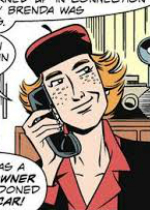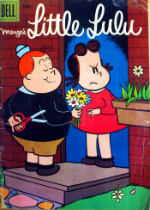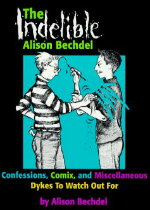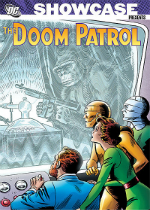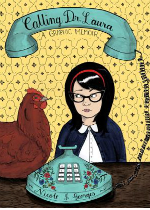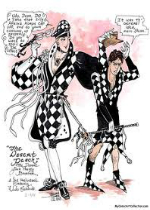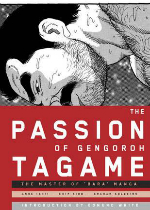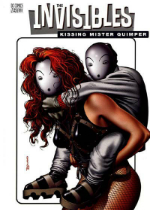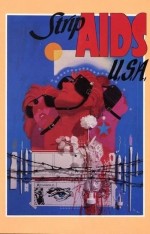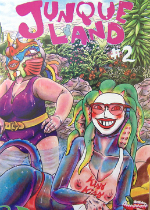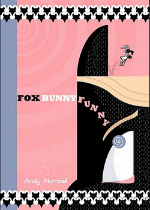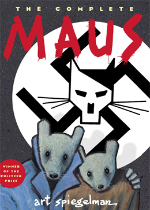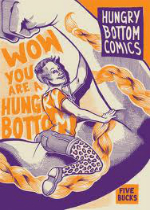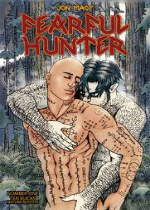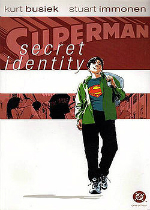Lambda Literary Comic Book Week: Graphic Artists and Novelists on the Comic Books They Love
Author: Paige Cohen
July 7, 2013
Graphic artists and cartoonist have shaped the art of storytelling in a manner incomparable to any other creative medium by introducing us to narratives reliant on neither text nor images but a unique combination of the two. Over the past several decades, these stories have served as touchstones for many within the LGBTQ community–from the outcast mutant teens showcased in the X-Men to the day-to-day lives of queer women in the celebrated Dykes to Watch Out For.
This week Lambda Literary is honoring the comic book medium by transforming the Lambda Literary Review into something a little more like the Lambda Comic Review. We have asked some of today’s most prominent LGBT authors to share with us the comics and graphic novels (LGBT or non-LGBT) that hold a special place in their memories, or have inspired them throughout the years. Today we are sharing their answers with you.
Jennifer Camper
Jennifer Camper is a cartoonist, artist, writer and graphic designer living in Brooklyn, New York. Her art examines life from a perspective that is irreverent, female, queer, and mongrel (Lebanese-American). Her work often explores gender, race, class and politics, as well as sexuality, mermaids and robots. Her books include Rude Girls and Dangerous Women, a collection of her cartoons, and subGURLZ, a graphic novella following the adventures of three women living in abandoned subway tunnels, among others.
This question is impossible for me to answer so I’m posing another question instead:
What are the first lesbians you saw in comics?
The character Hank O’Hair in Brenda Starr, Reporter (1940-2011), created by Dale Messick and later done by Romona Fradon, and then still later by Linda Sutter and Mary Schmich and June Brigman.
Brenda’s newsroom pal, Hank, usually dressed in men’s clothing and was very butch. Hank wasn’t explicitly lesbian, and I think she even had a husband at one point. She was written as a plain woman, not glamorous like Brenda, and she was tough, practical and good at her job. Her name, character, appearance and actions were all consistent with her being a swaggering dyke. I discovered her when I was young and was fascinated by her.
Come Out Comix by Mary Wings (1973)
The first “underground” lesbian comic in America. Mary did other comics, Dyke Shorts and Are Your Highs Getting You Down? Later she wrote dyke detective novels.
Dynamite Damsels by Roberta Gregory (1976)
The first “regulation-sized” comic published by a woman. This story had lesbians, feminists, and “alternative” culture. Roberta went on to create many comics, including Winging It, Artistic Licentiousness, Naughty Bits, and many collections featuring Bitchy Bitch and angry dyke Bitchy Butch.
Howard Cruse
Howard Cruse’s comic strips and humorous illustrations have appeared in Playboy, The Village Voice, Artforum International, Harpoon, Heavy Metal, The Advocate, Starlog, and numerous other national magazines. Seven books have been published compiling Cruse’s own comic strips and stories from underground comic books and elsewhere: Wendel (1986); Dancin’ Nekkid With The Angels (1987); Wendel on the Rebound (1989); and Early Barefootz (1990); Wendel All Together (2000; supplanted in 2011 by The Complete Wendel); From Headrack to Claude (2009); and The Other Sides of Howard Cruse (2012). Cruse’s most widely known book is the critically acclaimed graphic novel Stuck Rubber Baby.
My Early Influences:
There were no openly gay cartoonists to be inspired by when I was a kid in the 1950s — but then, I didn’t know that I was going to be gay then, either. But I can still trace aspects of the cartooning sensibility on view in the comics (gay and otherwise) that I’ve drawn in my adulthood to the following three seminal role models.
Marge’s Little Lulu by Marjorie Henderson Buell / John Stanley
The first comic-book title that I followed religiously was Little Lulu, which I had discovered by the time I was six. The characters had been originally created for magazine gag cartoons by the “Marge” above the title, but their comic-book incarnations appeared in stories scripted (anonymously, at the time) by a man named John Stanley.
Lulu stood head and shoulders above most other kids’ comics because Lulu Moppet and her playmates seemed to have genuine inner lives. Sure, they were funny — but in a nuanced way. They seemed to think thoughts, not just do stuff at a writer’s command to fill out a plot-line. Poring over Little Lulu comics helped me begin to learn how to build characters from the inside out.
Li’l Abner by Al Capp
Although I did my best to master the short “gag-a-day” style popular in newspaper comic strips because I thought I would have to, I always felt hemmed in by that format’s brevity and reliance on quick set-ups and punch lines. Al Capp’s Li’l Abner showed me a more expansive way to be funny. In continuities that lasted for weeks, Capp’s brainchild lampooned politics and cultural mores by transforming them into deceptively sophisticated hillbilly burlesque. Using an ever-expanding cast of quirky characters, Capp could always find someone in the Dogpatch ensemble to embody the national folly of the day. I used a similar strategy (minus the hillbilly angle) in Wendel, the comic strip I drew regularly for The Advocate during the 1980s.
During my college years I veered away from cartooning into theatre. The superhero onslaught of the 1960s had left the comic book industry of that era hopelessly addicted to fantasy, whereas stage plays offered endless opportunities to explore human experience as it’s actually lived, with the unhampered language, moral ambiguities, and fascinating subtexts that live actors could convey and inked lines on paper seemingly couldn’t.
But the career of Jules Feiffer, who wrote and drew a long-running series of psychologically subtle comic strips for The Village Voice, made me question the notion that being a cartoonist necessarily meant looking at life cartoonishly. Feiffer could portray pungent fragments of human comedy succinctly in his comic strip, but began branching out into theatre (as with Little Murders) and screenwriting (as with Carnal Knowledge) when he wanted to address larger ideas expansively.
This could have been an argument for leaving comics behind permanently, of course, since I enjoyed writing and directing plays but didn’t have a parallel print venue waiting for me the way Feiffer did. But then came underground comix. Examples like Justin Green’s Binky Brown Meets The Holy Virgin Mary, R. Crumb’s fearless explorations of the human id, and any number of perceptive personal comics by a newly empowered cadre of female cartoonists showed me that the expressive depth that was possible in plays could be successfully transferred onto paper. Suddenly there seemed to be a place for me in comics after all, and I began the succession of cartooning experiments that eventually led to Stuck Rubber Baby.
kris dresen
kris dresen is an artist and writer living in Chicago. She’s the illustrator of the critically acclaimed comic book Manya, written by Jen Benka, and the writer and artist of her solo strip, Max & Lily. Previously awarded the Xeric Grant, Kris and Jen were nominated for an Eisner Award for their work on Manya. After migrating her work to the web, Kris serialized her fist full-length online graphic novel, Grace. She followed that with a graphic short story, she’s in the trees, and is currently serializing her next online graphic novel, she said.
Dicebox by Jenn Manley Lee
Beautifully drawn, wonderfully written, and epic in scope, Dicebox is everything that’s good about graphic novels/comics/storytelling. Jenn’s vision is absolutely lovely and her drafting skills are sublime.
Why I Hate Saturn by Kyle Baker
This book made me realize the potential for comics back when it was all still pretty much superheroes and the indies were just starting to bubble up. This book is funny as hell, smart, have great characters, and layout that was startling (to me anyway) at the time. I love this book. Why I Hate Saturn got me back into drawing and writing comics. It’s truly all Kyle Baker’s fault.
The Arrival by Shaun Tan
Gorgeous art. Wordless. A magnificent work that transcends language and culture.
Dylan Edwards
The cartoons of Dylan Edwards (the artist occasionally known as NDR) have been published in a variety of venues, both in print and online, including his book Transposes (Northwest Press) and the Fantagraphics anthology No Straight Lines. You may remember him from such comics as his ongoing series Politically InQueerect, his sports-themed cartoon The Outfield (published on OutSports.com from 2002-2009), and an editorial cartoon focusing on queer issues that ran from 2004-2005 in the Texas Triangleand TXT Newsmagazine.
The Indelible Alison Bechdel by Alison Bechdel
As a comics creator I’m a big-time process junkie, so it’s great to be able to read in depth about Alison’s creative process, and to see the evolution of her work in a single volume. This book predates Fun Home by a few years, so it’s mostly about Dykes to Watch Out For and other lesser-known work of hers.
Kiss & Tell: A Romantic Resume, Ages 0 to 22 by MariNaomi
MariNaomi does a great job of mixing humor and drama in her work, and does an excellent job with a minimalist art style. This autobiographical book includes an examination of her bisexuality.
Krazy Kat by George Herriman
This is a classic comic strip, often obscure to people who aren’t cartoonists themselves, but frequently revered by comics creators for its inventive use of layout and language. I rarely see it name checked in queer comics lists, even though the titular character is genderqueer (and existed long before the term “genderqueer” was even coined). Krazy Kat was a newspaper strip that ran from 1913 to 1944. Krazy is in unrequited love with a mouse named Ignatz. Ignatz is always male, but Krazy’s pronouns change from comic to comic: sometimes he’s a he, sometimes she’s a she. Herriman took some flak for having a (sometimes) male cat be in love with a male mouse, and his ultimate statement on Krazy’s gender is that Krazy is a sprite and not really beholden to the gender norms of humans.
Tim Fish
Tim Fish writes, draws and publishes a variety of comics. Tim’s work includes his graphic novel Strugglers and an anthology of his off-beat mini comics Something Fishy This Way Comes, and a “mainstream” story in Marvel’s romance anthology, I ♥ Marvel, among others. Serving as editor for both the Web and print versions, Tim published the gay romance anthology Young Bottoms in Love which includes stories and art from Tim and more than 40 other creators—all in beautiful color.
Showcase Presents: The Doom Patrol (DC Comics)
Forget Grant Morrison’s acclaimed run, I love the original series which kicked off in 1963. The team combines the “family” aspect of The Fantastic Four with the “outsider” aspect of X-Men. The stories are a bit goofy, a bit campy, and like most comics written for kids but read as adults, extremely unrealistic. So why do I like the series? Pft, didn’t I say goofy and campy?
In addition, I love Elasti-Girl. Aside from Wonder Woman, most heroines at that time (both DC and Marvel) had defensive, cerebral, or weak powers, often taking the backseat roles to their male teammates. Not Elasti-Girl, who could grow to enormous heights and shrink to incredibly tiny proportions. Pre-inhaling power-inducing volcano-vapors, she was a gold medal winning Olympic swimmer turned action movie star. As a member of the Doom Patrol, she was eager for her turn and her part to play, and in terms of power, held her own with Robotman and Negative Man. Her jokes and analogies weren’t make-up, clothing, and flowers, but sports. She blackballed her hero-boyfriend Steve “Mento” Dayton from joining the team, to preserve her “family” as-is. And, when she married him, she didn’t retire with her Mrs. degree.
No need to scour comic shops and eBay for back issues, DC has collected the run as Showcase Presents: The Doom Patrol.
Hopeless Savages (Oni Press)
Writer Jen Van Meter teams with various artists for each Hopeless Savages mini-series. As a reader, I gravitate to books based on art first, writing second. And, I’ve loved most of the art on the various series…some more than others. But even with “the others,” the writing and characters are so amazingly compelling. I anxiously await each new book.
The story centers around a couple of former now married punk rockers, their four children, and their children’s partners where applicable. The treatment of Twitch, the gay son, is so seamless – I actually did a double-take and re-read it. The subject is neither ignored nor on display. It just is. He just is. It’s heart-warming to read about a family who just rolls with it, without drama or care aside from the care they show every other family member. While this sort of treatment is more and more common in entertainment, it wasn’t so much when Oni Press first started publishing the series.
The first collection is great, the second I love for the really touching Twitch segment drawn by Chynna Clugston, but really, just get the complete jumbo collection (the first 3 series in one book) and keep your eye out for the upcoming series.
Ellen Forney
Cartoonist Ellen Forney is the author of NYT bestseller Marbles: Mania, Depression, Michelangelo, and Me, and the 2012 “Genius Award” winner in Literature from Seattle’s The Stranger. She collaborated with Sherman Alexie on the National Book Award-winning novel The Absolutely True Diary of a Part-Time Indian, created the Eisner-nominated comic books I Love Led Zeppelin and Monkey Food, and has taught comics at Cornish College of the Arts since 2002. She grew up in Philadelphia and has lived in Seattle, Washington since 1989. Ellen swims and does yoga, and fixes things with rubber bands and paper clips.
It’s always so hard to pick favorites! Here are a few:
Fun Home by Alison Bechdel
I always recommend this for people who are book-readers but not familiar with graphic novels, and ask me where to start. Fun Home is so smart, and a beautifully constructed story. Alison has always been my cartoonist hero anyway!
The Infinite Wait and Other Stories by Julia Wertz
I love the cute rubbery way she draws, which belies her candor and her dark dark humor.
Calling Dr. Laura by Nicole Georges was just released.
It’s a quirky and charming memoir, totally enjoyable, delicious to look at.
These are all memoirs… I guess a lot of my favorites are memoirs! I Can’t Tell You Anything by Michael Dougan, You’ll Never Know by Carol Tyler…okay, I’ll stop.
Roberta Gregory
Roberta Gregory has been creating her own unique comics for over twenty years. She appeared in many issues of Gay Comix/ Gay Comics and self-published Sheila and the Unicorn and Winging It, both of which studied gender issues. She also self-published two of the three issues of Artistic Licentiousness, which she describes as “a sort of bisexual love story.” Roberta is best known in the comic world for her long-running Naughty Bits series, starring the unforgettable Bitchy Bitch.
The Desert Peach series by Donna Barr
One of my favorite LGBT comics was Donna Barr’s long running The Desert Peach series, printed in many collections through the years,
beginning, I believe in 1991, before there was anything like it. Well-written, beautifully drawn and humorous, and very articulate, these stories starred a gay German officer on the North African front during the second World War, and from this very unique perspective, had so much to say about history, politics, war, the human condition, as well as sexuality, of course. There still is nothing like it.
The Desert Peach currently continues with an even more imaginative and surreal storyline under the title Afterdead, both in print and as a web comic.
Justin Hall
Justin Hall is a cartoonist living in San Francisco with his partner and their pet python. Justin has won both the Xeric Award and the Prism Comics Queer Press Grant for his work, which includes the series True Travel Tales, Hard To Swallow (with Dave Davenport), and Glamazonia the Uncanny Super Tranny. He’s the editor of No Straight Lines: Four Decades of Queer Comics, a massive collection of LGBTQ comics published by Fantagraphics Books, which won the 2013 Lambda Literary Awards.
A few great LGBTQ comics caught my attention this last year.
Marbles by Ellen Forney
Ellen Forney’s Marbles is a fantastic memoir graphic novel about her battle with bi-polar disorder, and Forney includes her bisexuality into her story with an easy and unforced literary grace. Forney is a master cartoonist, and has pulled out all the stops on this book, her most ambitious to date.
Oh Human Star by Blue Delliquanti
An excellent webcomic was awarded the Prism Comics Queer Press Grant last year (along with Christine Smith’s The Princess), and deserves plenty of attention. Oh Human Star, by Blue Delliquanti, is a fantastic sci-fi story about a young, gay robotics genius whose dead, older lover has been brought back as two Artificial Intelligence constructs, one a replica of the original body, and the other that of a young woman. It’s a very sophisticated take on what human connections mean in a future where identity can become extremely complex. Plus, the illustrations and cartooning techniques are truly wonderful to behold.
Hungry Bottom Comics by Eric Kostiuk Williams
Finally, my favorite self-published “mini-comic” to come out last year was Hungry Bottom Comics by Eric Kostiuk Williams. Williams is a remarkably gifted, young, gay cartoonist who tackles memoir in an unusual way, with dense, lush illustrations and deconstructed page layouts, combined with a surreal, magical realism literary style. Williams is pushing boundaries while being very knowledgeable of both LGBTQ artistic history and the comics medium. We’re going to continue to see amazing things from him.
Oh, and one more!
The Passion of Gengoroh Tagame by Chip Kidd (editor), Anne Ishi (translation), Gengoroh Tagame (artist), and Edmund White (Introduction)
I’ve been waiting many years for The Passion of Gengoroh Tagame, the first English translation of the great gay erotic manga master’s work. And this newly published edition surpassed all expectations… Chip Kidd designed a phenomenal book, and Anne Ishi did a great job with the translations; the result is a fantastic introduction to one of the most challenging and remarkable erotic artists in the world.
Joan Hilty
Joan Hilty is an independent editor and packager of fiction and nonfiction. She specializes in graphic novels, developing and managing projects for writers, artists, literary agents, and publishers. As a senior editor at the DC Comics/Vertigo imprint, she acquired and edited award-winning original graphic novels, including Cairo, Cuba: My Revolution, Gone to Amerikay, Shooters, and Bad Houses.
Marbles by Ellen Forney
The Eisner-nominated and National Book Award-winning cartoonist’s graphic memoir is brilliant on several levels, and not just because it was a New York Times bestseller. She tells a spellbinding story of being diagnosed with bipolar disorder and struggling for years to bring it under control while maintaining the artistic creativity that, to a certain degree, it fed. It’s a journey that pulls in her boyfriends and girlfriends, family,
and fellow artists, but can only be completed by her. And it’s done with a dazzling array of visual metaphors and emotionally intense storytelling, the kind that only the graphic novel can pull off.
The Death of Speedy by Jaime Hernandez
Of the many storylines compiled in trade paperback from the legendary Love and Rockets comic series by the Brothers Hernandez, this is probably my favorite. The tragic tale of East LA gangbanger Speedy Ortiz and his childhood friend Ray Dominguez interweaves beautifully with the long-running love story of L&R protagonists Hopey and Maggie, complete with a women’s wrestling championship and a millionaire mistress’s superheroine aspirations. Virtually impossible to describe—you’ve just got to read it.
Victor E. Hodge
Victor E. Hodge is a mystery and horror writer and illustrator living in Washington, D.C. BlackGay Boy Fantasy (otherwise known as BGBFantasy) is a mini comic about black gay and lesbian life in Washington, D.C. It began as a one-shot strip for the 1996 DC Black Lesbian and Gay Pride Guide. The first issue was sold at Boston’s Outwrite ’98. Those characters also starred in the Little Dramas comic strip which was featured on the Women In The Life website.
Complete Hothead Paisan: Homicidal Lesbian Terrorist by Diane DiMassa (1999)
Diane DiMassa caught me by surprise. When I was new at discovering underground comics, Hothead scared me. I admit it. She was a man-hating/straight folks-hating, ax-weilding/gun-toting wild haired angry lesbian homical terrorist. And, she had a cat named Chicken. But, when I read it, I realized not only did “they” deserve it, they got it good!!! I cheered and rooted for Hothead and I cried with her as she struggled for understanding, love and compassion. I understood everything she was going through. Diane DiMassa really worked me emotionally in those stories, especially when she spoke directly to her constantly misunderstood character, Hothead.
Curbside Boys: The New York Years by Rob Kirby (2002)
I have always been a fan of Rob’s work. And, his adventures of gay men spoke directly to me as a young black gay man in Washington, DC. And, it was nice to see other black people woven seamlessly into these truthful, wonderful, funny and warm stories. He captures anticipation and heartbreak like nobody else. He took characters that weren’t perfect or even sometimes likeable and made them normal. I saw a lot of myself or people I knew in these stories. Plus, he’s hilarious!!!
Glamazonia: The Uncanny SuperTranny by Justin Hall (2010)
I’m a big fan of Justin’s, particularly his travel tales. Glamazonia is just pure fun that actually takes itself serious. I love superhero comics. I love queer comix. I love erotica. And, Justin found the perfect balance between them all. I have never seen more fun and intelligence spew from the page. And, the blatant sexuality doesn’t hurt either!!!!
Phil Jimenez
Phil Jimenez is a storyteller by trade and by passion. He writes and draws comic books for a living — think Astonishing X-Men, Amazing Spider-Man, Wonder Woman, Infinite Crisis, Otherworld, and Teen Titans – but he’s spent his whole life telling stories of some fashion with words, pictures, or both. (He’s also done design work for film, TV, magazines, museums, and public spaces.)
The Invisibles by Grant Morrison
I love Grant Morrison’s Invisibles series, and still think it’s one of the queerest things ever published by DC – not just because of the Lord Fanny drag queen character, but because of the overall aesthetic.
Green River Killer: A True Detective Story by Jeff Jensen (Author) and Jonathan Case (Artist)
And speaking of queerness in these broader terms, one of my favorite graphic novels of the last few years was Green River Killer, about one man’s crusade to find the notorious serial killer who murdered large numbers of prostitutes up in Seattle, women who were endangered by being sexual outsiders.
David Kelly
David Kelly is a comics artist in Seattle. A new compilation, Rainy Day Recess: The Complete Steven’s Comics, is just out from Northwest Press. David’s work can also be seen in Boy Trouble, which he co-edited with founder, Robert Kirby. David’s comics have appeared in The Stranger, Juicy Mother: How They Met, Gay Comics, Stereoscomic, and in numerous ‘zines and weekly newspapers.
The Freddie Stories by Lynda Barry (Drawn & Quarterly, 2012)
A compilation of comics by Lynda Barry focusing on the teen character Freddie Mullen, the younger brother of main characters Marlys and Maybonne, all of whom come from a dysfunctional family and home life. There is light at the end of the tunnel as Freddy shouts “I am El Fagtastic” with joy and strength, amidst dark and moving stories of arson, juvenile detention, and siblings.
Strip AIDS USA (comics anthology edited by Trina Robbins, Bill Sienkiewicz, and Robert Triptow. Last Gasp, 1988)
I found this book during my final year of college. I was already familiar with the work of two of the editors of this anthology. Trina Robbins was a
contributor to a Katy Keene (Archie Comics fashion/movie star character) zine that I read in the early 1980s and Bill Sienkiewicz was a “Marvel” comics artist and painter whose work I very much admired. Comics about gay life by queer cartoonists were not necessarily readily available in a small college town, but this book was. While the subject matter was often dark, sad, and depressing, the comics in this book are filled with anguish, frustration, and love. This book was my first exposure to queer comics and gay cartoonist greats like Alison Bechdel, Howard Cruse, Robert Triptow, Jennifer Camper, and many, many more.
Akbar & Jeff’s Guide to Life by Matt Groening (Pantheon, 1989)
Selected compilation of Groening’s recently departed Life in Hell comic strip, featuring gay fez-wearing couple Akbar & Jeff. They co-habitate, love, play, argue, start businesses, and fight homophobia! Good for light reading and hearty laughs.
Edward Luce
Ed Luce’s first comic book project, Wuvable Oaf, is a “fairy” tale chronicling one big, scary lookin’ dude’s search for romance in a city that looks suspiciously like San Francisco. Ed and Oaf had the very great honor of being named co-recipient of Prism Comics 2010 Queer Press Grant (thanks guys)! They have also been nominated for a 2009 Ignatz Award in the “Promising New Talent” category.
Junqueland #1-3 by Robin Bogert and Jason Fischer
Pansexual Anthrophomorphic Monster Porn, rendered with a very compelling combination of boldness and tenderness. It’s just beautiful work.
Pregnant With Desire/Loose In San Francisco by Beth Dean
She’s just starting to gather a body of comics work, but Beth is carving out a space for herself I haven’t really seen so far in comics. If I could describe her work in the briefest terms: Sardonic Satanic Heavy Metal Lesbian Misadventures. One to watch!
The Passion of Gengoroh Tagame by the man himself
Tagame almost single-handedly created the bara manga genre and this is the first collection of his work in English, courtesy of Chipp Kidd, Anne Ishii and Graham Kolbeins. I own a few Japanese language versions, purely for the enjoyment of his undeniably powerful art. But being able to really read these stories for the first time, I finally understand how important the details of each scenario are to the erotic impact of the story.
Jon Macy
Jon was part of the early Nineties black and white boom with the series Tropo. It was followed by the erotic horror comic series Nefarismo from Eros/Fantagraphics. Since then he has created strips for Gay skin magazines such as Steam, Wilde, Bunkhouse, and International Leatherman, as well as anthologies; Gay Comix, Negative Burn, Meatmen, Friend of Dorothy, So Super Duper, Three, Glamazonia, and Boytrouble.
Curbside boys: The New York Years by Robert Kirby
This tale of twenty something’s Rings true with all the pain of discovering who you are, and who you should, (or should not) be with. Kirby balances a large castline work is playful which cleverly disguises the darkness just beneath.
Fox Bunny Funny by Andy Hartzell
I normally find silent comics light, and too quick a read, but this was so meaty and original that I was left totally satisfied. The use of animals instead of people made the themes universal and sneaky. You don’t see the sucker punch coming.
Fogtown by Andersen Gabrych and Brad Rader
Noir mysteries are dark and gritty stories where all the characters are somehow flawed—so I see no reason that gay men should not get the same treatment as everybody else. This is a powerful tale of murder and violence where a closeted gay man fights his demons as much as the bad guys. It’s horrifying and touching in turns.
Erika Moen
Erika Moen is a freelance cartoonist born June 25, 1983 and graduated with an Illustrated Storytelling self-designed degree from Pitzer College in 2006. She lives in Portland, Oregon where she has been a member of Periscope Studio since 2008. Having created comics for well over a decade, her work has been published by Dark Horse, Image, Villard and Scholastic, among many others. In addition to creating comics, she also regularly teaches classes and guest lectures on the subject in high schools and colleges around the country.
Blue Monday series of four books by Chynna Clugston
They are hilarious, smart and human.
Allan Neuwirth
Allan Neuwirth is a native New Yorker who writes, creates, develops, produces, directs, and designs animated TV series, screenplays, books, a syndicated comic strip, comic books & graphic novels, games, music videos, and award-winning animated TV commercials. In 1998, with illustrator/writer Glen Hanson (designer of MTV’s Spy Groove), Allan co-created the popular comic strip Chelsea Boys.
There are so many graphic novels that I love, it really is hard to narrow it down to just three. But since I must… in no particular order, three of my favorites are:
Stuck Rubber Baby by Howard Cruse
I’m certain I’m not the only one to cite this groundbreaking blend of masterful storytelling and exquisitely drawn artwork. I consider Howard’s book the granddaddy of all LGBT graphic novels. It made me laugh, and it really made me cry. Deeply moving and epic in scope. SRB is more than a graphic novel—it’s a great work of literature, at once a story about the civil rights movement, coming out as queer, and a coming of age tale. A must read. Should have been adapted into a major motion picture many years ago.
Maus by Art Spiegelman
Another one sure to be cited by others… but this tremendous (and justifiably award-winning) book, or pair of books, holds special meaning for me. As the child of a Nazi holocaust survivor myself (my mother was imprisoned in Auschwitz, the only surviving member of her large family), I could identify with Spiegleman’s recounting of his own life dealing with his father’s unique neuroses. The genius of Maus, apart from its brilliant writing and unique artwork, was that the author told a dual story, making the tale just as much about himself. For several years I eagerly awaited each issue of Raw Magazine, where the novel first ran as installments in a self-contained, undersized attachment pasted to the inside back cover. I still treasure my old copies.
In Bed with David & Jonathan by Tom Bouden
I adore Bouden’s simple, evocative, cartoony drawing style and lovely page compositions. I admire the simplicity of the storytelling, and many of the long, strictly visual, wordless passages. Plus the erotic nature of the stories are a major turn-on. Some would consider this graphic novel to be soft core (maybe even hard core) porn… but it’s so beautifully executed, and so honest in its depiction of everyday life between two gay lovers. Just wonderful!
Rachel Pollack
Rachel is considered one of the world’s foremost authorities on the modern interpretation of the Tarot. She is also a poet, an award-winning novelist, and a Tarot card and comic book artist. She has published 12 books on the Tarot, including 78 Degrees of Wisdom (Thorsons, 1998), considered a modern classic and the Bible of Tarot reading. As a fiction writer, Pollack has been bestowed many honors and awards, among them the famed Arthur C. Clarke Award for Science Fiction (for Unquenchable Fire) and the World Fantasy Award (for Godmother Night).
No Straight Lines edited by Justin Hall
I’m a great admirer of No Straight Lines, edited by Justin Hall. It shows the richness and variety of lesbigaytor creators, but also the ways in which the medium of comics allows a freedom that greatly aids the expression of minority experience.
Dykes To Watch Out For by Alison Bechdel
I’ve also always admired Alison Bechdel’s long-running Dykes To Watch Out For. While I see the value and depth of her recent family memoirs I always found that DTWOF was phenomenal at chronicling the many turns of lesbian culture.
Marian Runk
Marian is a Texan born, Chicago-based cartoonist who loves birds, cats, and country music. The Magic Hedge, her autobiographical comics series about birdwatching, family, reality t.v., HIV/AIDS, queer stuff, and the awkwardness of childhood, was nominated for an Ignatz Award in 2011. When she’s not at her day job (peddling birth control and promoting safer sex to the Chicagoland area), she’s probably drawing comics, playing guitar, singing in a choir, or watching birds along the shore of Lake Michigan.
Gaylord Phoenix by Edie Fake
Stunningly beautiful psychedelic narrative about love, loss, desire, sex, and transformation—what’s not to love?!
Hungry Bottom Comics series by Eric Kostiuk Williams
I appreciate this young cartoonist’s stylistic and thematic respect for queer and underground comics that have come before him…And I admire his drawing chops and commitment to contemporary, autobiographical stories.
And, like everyone else, I would not be here but for Alison Bechdel (everything she writes, always), Howard Cruse (specifically Stuck Rubber Baby), and Jennifer Camper.
Sina Shamsavari
Sina Shamsavari entered the London underground queer punk scene at the age of 16 with the queer teen zine Concerned Muthers. Shamsavari went on to create and self-publish small-press comics such as the gay superhero saga Atomic Love and the personal BoyCrazyBoy.
I guess my favourite books would be:
Curbside Boys by Robert Kirby
Because of its relatability, its sweetness, and its focus on emotions and relationships rather than the mainstream gay scene.
Fearful Hunter by Jon Macy
Because of the supernatural and fantasy elements and the strong romantic love story, as well as lush beautiful art, that makes it stand out amongst queer comics.
Christine Smith
Christine Smith is the creator of Prism Queer Press Grant winning comic The Princess about a little transgender girl. She is currently creating a trans* community project to produce a graphic history of gender transgression. She lives in the Diablo Valley of California with her wife Heather Rose Brown, bringing to life the world and characters that live in her imagination.
Doom Patrol #64 -#87 by Rachel Pollack
DC Comics’ first transgender character…. Was she a supporting character? Some friend or roommate of someone else we’ve heard of? No! She was a superhero! Following Grant Morrison’s run on the title, transsexual writer and occultist Rachel Pollack took over. Her run introduced us to Coagula, a transsexual heroine with the power to turn solid things fluid… a witty homage to what transfolk do to traditional binaries of gender and sexuality. Her run was marked by exploration of gender expression, and the tensions between body and gender, raising interesting questions and exploiting the superhero genre for metaphor. As she was asked what makes her a woman, Coagula responded by asking what makes Robotman a man, given his rough, featureless robot body. It was important work that has been forgotten since. Alas, Coagula was killed off in the first Doom Patrol story after Ms. Pollack’s run. It has never been reprinted. Coagula has been forgotten. Hopefully someday some queer archeologist of pop culture will rediscover this work and build demand for a full reprint. Until then, there’s eBay.
The Plain Janes by Cecil Castellucci and Jim Rugg
So far, this original graphic novel is the best thing DC’s put out in this new century, and it’s off the radar of most comic fans. It was published under DC’s ill fated imprint “Minx”, a line of original graphic novels for girls. Written by author Cecil Castellucci it was the story of four high school girls all named Jane, and a gay male peer who serves as an honorary Jane. Following trauma, a girl chooses to pass by the cool girl table in her school cafeteria to sit with the outcast Janes. Together, they find healing and unity through the redemptive power of making art. It’s a beautiful story of outsiders bonding together to be redeemed by creating beauty. It’s an essential read. The Minx line is discontinued, but you can still find this one (and its sequel, Janes In Love) on eBay for a very reasonable price.
Stuck Rubber Baby by Howard Cruse
Howard Cruse created this thinly veiled piece of historical fiction. Set in the American South during the early 60s, it is a profound meditation on the intersection of civil rights and entrenched prejudice in our civil life. Juxtaposed with the struggle for civil rights for African Americans, we also see small town southern life for LGBT folks. It offers a cross section of Southern society. Where ignorance is found one always finds the enlightened struggling against it. Where hate casts a shadow, lovers light a candle. In the end, it is a story of the vicious toll taken by prejudice and the resistance of the kind, the generous, and the loving. Bittersweet, emotional, truthful, and well written, this is essential reading for any devotee of the graphic novel form. It is comics at the most emotionally resonant and thematically truthful. With this work, Howard Cruse establishes himself as a master of the form. It is essential reading, so read it!
Alex Woolfson
Alex Woolfson grew up loving science-fiction and action movies, but never got to see what he really wanted to see—kick-ass genre stories with real heroes who just happened to be gay. After starting a successful career as a filmmaker in the Bay Area, he soon realized the best way to create the “big-budget” adventure stories he craved would be as full-color comics. He teamed up with illustrator Winona Nelson to create the science-fiction graphic novel, Artifice, and in 2011, started posting pages from it on his Website, Yaoi 911 Webcomics. He currently lives in the Bay Area where he is writing scripts for his latest superhero webcomic The Young Protectors.
While I have a number of “favorite,” beloved comics that I draw inspiration from, there are three books I feel particularly speak to me as a creator.
Dykes To Watch Out For by Alison Bechdel
First would be Alison Bechdel’s Dykes To Watch Out For which was the first work in any media that showed me strong, unapologetic, joyful gay characters I could identify with. (I was a particular fan of sex-positive Lois.) As a gay teen, Dykes showed me comics could be smart and funny—and taught me that seeing people like yourself depicted as heroes is a powerful antidote to a world committed to convincing you that you are worthless.
Secret Identity by Kurt Busiek
Kurt Busiek’s Secret Identity, a meditation on the seasons of a man’s life that masquerades as a Superman story, taught me that even fun genre comics could be compelling, thoughtful literature. I still think of its final pages when contemplating my own future and mortality.
Persepolis by Marjane Satrapi
Finally, Marjane Satrapi’s Persepolis cemented in me the belief that comics—with the absorbing, powerful visuals of movies but slower, more thoughtful absorption rate of books—are the perfect medium for putting yourself in another’s shoes and thus bringing us all closer together. On the surface, I share little in common with a young Iranian girl growing up just after the Islamic Revolution; yet I could completely identify with the heroine and now feel a strong connection to a people and a culture that I would otherwise find alienating.
I notice none of my picks had gay male protagonists. While I deeply admire comics like Howard Cruse’s Stuck Rubber Baby, I think my choices speak to what I love most about comics: that through these stories of very different people, we can learn we really aren’t so different; and through their characters’ heroism, we can discover the hero within ourselves.

